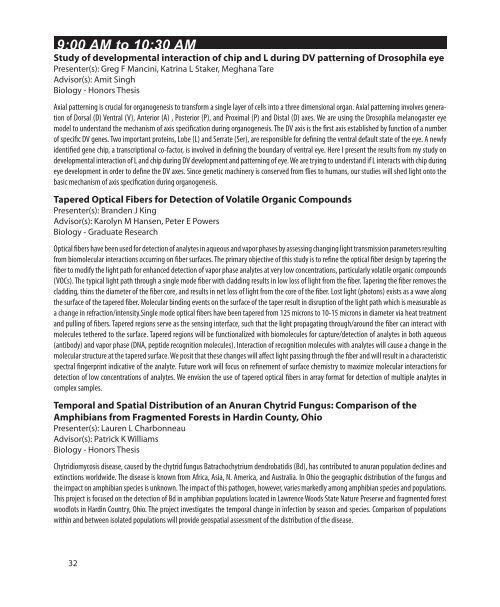Stander Symposium abstract book - University of Dayton
Stander Symposium abstract book - University of Dayton
Stander Symposium abstract book - University of Dayton
Create successful ePaper yourself
Turn your PDF publications into a flip-book with our unique Google optimized e-Paper software.
9:00 AM to 10:30 AM<br />
Study <strong>of</strong> developmental interaction <strong>of</strong> chip and L during DV patterning <strong>of</strong> Drosophila eye<br />
Presenter(s): Greg F Mancini, Katrina L Staker, Meghana Tare<br />
Advisor(s): Amit Singh<br />
Biology - Honors Thesis<br />
Axial patterning is crucial for organogenesis to transform a single layer <strong>of</strong> cells into a three dimensional organ. Axial patterning involves generation<br />
<strong>of</strong> Dorsal (D) Ventral (V), Anterior (A) , Posterior (P), and Proximal (P) and Distal (D) axes. We are using the Drosophila melanogaster eye<br />
model to understand the mechanism <strong>of</strong> axis specification during organogenesis. The DV axis is the first axis established by function <strong>of</strong> a number<br />
<strong>of</strong> specific DV genes. Two important proteins, Lobe (L) and Serrate (Ser), are responsible for defining the ventral default state <strong>of</strong> the eye. A newly<br />
identified gene chip, a transcriptional co-factor, is involved in defining the boundary <strong>of</strong> ventral eye. Here I present the results from my study on<br />
developmental interaction <strong>of</strong> L and chip during DV development and patterning <strong>of</strong> eye. We are trying to understand if L interacts with chip during<br />
eye development in order to define the DV axes. Since genetic machinery is conserved from flies to humans, our studies will shed light onto the<br />
basic mechanism <strong>of</strong> axis specification during organogenesis.<br />
Tapered Optical Fibers for Detection <strong>of</strong> Volatile Organic Compounds<br />
Presenter(s): Branden J King<br />
Advisor(s): Karolyn M Hansen, Peter E Powers<br />
Biology - Graduate Research<br />
Optical fibers have been used for detection <strong>of</strong> analytes in aqueous and vapor phases by assessing changing light transmission parameters resulting<br />
from biomolecular interactions occurring on fiber surfaces. The primary objective <strong>of</strong> this study is to refine the optical fiber design by tapering the<br />
fiber to modify the light path for enhanced detection <strong>of</strong> vapor phase analytes at very low concentrations, particularly volatile organic compounds<br />
(VOCs). The typical light path through a single mode fiber with cladding results in low loss <strong>of</strong> light from the fiber. Tapering the fiber removes the<br />
cladding, thins the diameter <strong>of</strong> the fiber core, and results in net loss <strong>of</strong> light from the core <strong>of</strong> the fiber. Lost light (photons) exists as a wave along<br />
the surface <strong>of</strong> the tapered fiber. Molecular binding events on the surface <strong>of</strong> the taper result in disruption <strong>of</strong> the light path which is measurable as<br />
a change in refraction/intensity.Single mode optical fibers have been tapered from 125 microns to 10-15 microns in diameter via heat treatment<br />
and pulling <strong>of</strong> fibers. Tapered regions serve as the sensing interface, such that the light propagating through/around the fiber can interact with<br />
molecules tethered to the surface. Tapered regions will be functionalized with biomolecules for capture/detection <strong>of</strong> analytes in both aqueous<br />
(antibody) and vapor phase (DNA, peptide recognition molecules). Interaction <strong>of</strong> recognition molecules with analytes will cause a change in the<br />
molecular structure at the tapered surface. We posit that these changes will affect light passing through the fiber and will result in a characteristic<br />
spectral fingerprint indicative <strong>of</strong> the analyte. Future work will focus on refinement <strong>of</strong> surface chemistry to maximize molecular interactions for<br />
detection <strong>of</strong> low concentrations <strong>of</strong> analytes. We envision the use <strong>of</strong> tapered optical fibers in array format for detection <strong>of</strong> multiple analytes in<br />
complex samples.<br />
Temporal and Spatial Distribution <strong>of</strong> an Anuran Chytrid Fungus: Comparison <strong>of</strong> the<br />
Amphibians from Fragmented Forests in Hardin County, Ohio<br />
Presenter(s): Lauren L Charbonneau<br />
Advisor(s): Patrick K Williams<br />
Biology - Honors Thesis<br />
Chytridiomycosis disease, caused by the chytrid fungus Batrachochytrium dendrobatidis (Bd), has contributed to anuran population declines and<br />
extinctions worldwide. The disease is known from Africa, Asia, N. America, and Australia. In Ohio the geographic distribution <strong>of</strong> the fungus and<br />
the impact on amphibian species is unknown. The impact <strong>of</strong> this pathogen, however, varies markedly among amphibian species and populations.<br />
This project is focused on the detection <strong>of</strong> Bd in amphibian populations located in Lawrence Woods State Nature Preserve and fragmented forest<br />
woodlots in Hardin Country, Ohio. The project investigates the temporal change in infection by season and species. Comparison <strong>of</strong> populations<br />
within and between isolated populations will provide geospatial assessment <strong>of</strong> the distribution <strong>of</strong> the disease.<br />
32

















